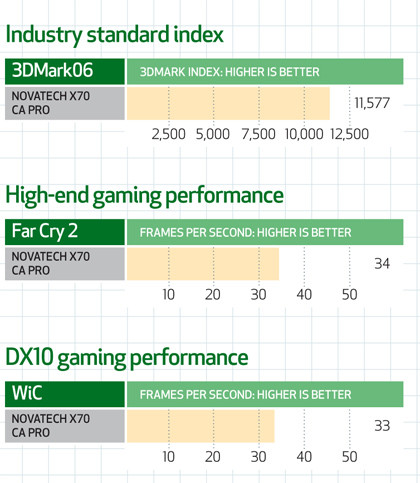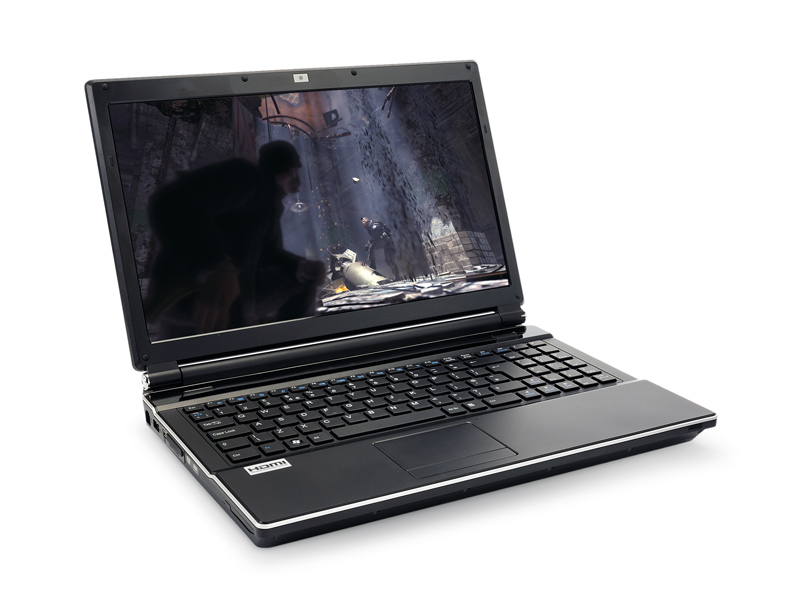TechRadar Verdict
A clear performer, but it just doesn't quite have the superstar looks to match
Pros
- +
Core i7 performance on demand
- +
Excellent screen
Cons
- -
Dull design
- -
Unresponsive mousepad
Why you can trust TechRadar
The Core i7 has taken so long to arrive in a notebook friendly form. It's here now though and the Novatech X70 CA PRO has one.
Hidden behind the 1080p, 15.6inch screen and tres chic-let keyboard of the X70 CA Pro is one of Intel's 720QM processors. That chip has four individual Nehalem hearts beating in unison beneath its silicon surface, with HyperThreading thrown in for octo-threading abilities.
The differences between this Clarksfield chip and a desktop Core i7 sound fairly cosmetic. A slightly smaller 989 pin package reflects the specialist notebook design, and there's only 6MB of level-3 cache in this model, rather than the 8MB in the other processors, but these differences are fairly slight.
The most remarkable change is that the Thermal Design Power (TDP) rating is just 45W, compared to 130W for the desktop chip. Theoretically, this chip consumes just a third the power of the Nehalems we've seen so far.
That's impressive, but the bad news is that this particular laptop still tops out at around two and a half hours of usage, although that's likely to be because of the top-end GeForce 280M graphics chip to which the CPU is coupled.
Stepping out
That low TDP is achieved, at least in part, due to an even more remarkable implementation of the well-established Intel Speed Step engine and the Turbo Boost feature than was present in the desktop Core i7 and Core i5 designs.
Sign up for breaking news, reviews, opinion, top tech deals, and more.
The former drops the CPU down to just 933MHz while it's just idling over keeping the desktop alive, helping to extend the battery life as far as it will go. The latter mainlines caffeine into its metallic veins and pushes it from its low 1.6GHz rated clockspeed up to a massive 2.8GHz when circumstances allow.
Those circumstances depend on how many threads are running at any one time, and how hot the CPU is running. When it's flat out on all four cores, the base clockspeed won't increase much.
Combined with the sheer number of threads it can handle even at the default speed, though, it's enough to eliminate CPU bottlenecking in the games we tested, especially when running at the native resolution of the screen, at which point the limitations of the graphics card are what's holding it back.
The 720QM may be the slower of the three available Clarksfield chips, but it easily matches the older, more power-hungry Core 2 design in performance - there's little difference between this notebook and our long-standing favourite, MSI GT725/729 laptops, other than a slight price advantage to the Novatech when you factor in the HD screen.
Outside of games, you'd have to trade up another £500 and add a couple of kilos for a laptop which can better this one in other desktop tests, like video encoding.
No lightweight
But what about the rest of the package? Well, the screen is excellent - the contrast filter is a little too reflective, but it's a bright, accurate and colourful display that does the hardware enough justice to make the new Supreme Court jealous.
The best that can be said for the chassis, though, is that it's a solid, but uninspiring design. At 3.3Kg it's not the lightest 15-inch laptop around, but for the amount of processing power available from both the CPU and the 280M graphics card it's far from unrealistically heavy.
The lid hinges are strong and conceal the power button on the right hand side, while the lid and keyboard surround are muted enough to be considered stylish. It's only below the edge of the keyboard that the design starts to look a bit bulky and, dare we say it, cheap.
The smooth matte finish on the top half tapers off to a coarser, less refined feel for the base. There are a fair amount of ports and plugs, including both HDMI and DVI, but compared to, say, Alienware's latest M15x – which is slightly cheaper – it's a distinctly old fashioned way of putting a laptop.
The thing is, the Alienware weighs more and is very much held back by a GeForce 260M graphics card, which doesn't quite cut it for games. It's the difference between Far Cry 2 being playable at high quality settings on the X70, while the M15x struggles even when the game engine is compromised.

The one thing that really grates is the mousepad. Why do netbooks come with responsive multitouch trackers, while a high performance machine doesn't even recognise the scroll area half the time? That's a mystery that will have to remain unanswered… for now.
Even with the Novatech's minor aesthetic faults and rather uninspired overall design, this is still one of only a select few notebooks that we'd actually consider buying specifically to play games on. The fact that it costs less than £2,000 is an impressive salute to the industry as a whole, and Novatech specifically.
The portable Core i7 may have been late, but if this is anything to go by, it was well worth the wait.
Follow TechRadar Reviews on Twitter: http://twitter.com/techradarreview
